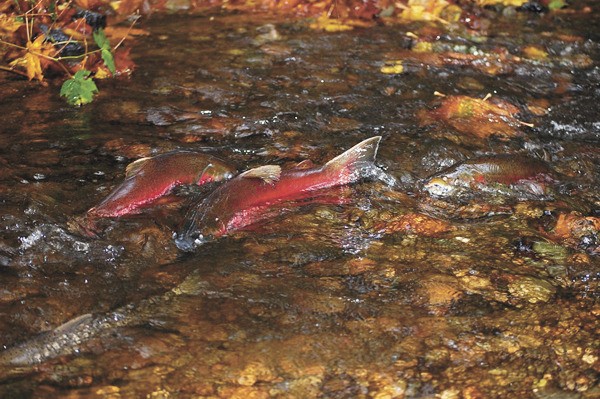On a dry, chilly morning last week, a small group of Islanders gathered at a culvert over Judd Creek and peered into the clear, rushing water.
“Do you see it?” one woman asked. Clad in workout clothes, she had come to the creek in Paradise Valley with two friends after an exercise class. They were joined by Tom Dean and Beth Bordner with the Vashon-Maury Island Land Trust, as well as another couple who stopped by the spot above the creek.
Suddenly a coho salmon jetted across the shallow stream, sending water splashing behind it. The small group erupted into cheers.
“This is a big event on Vashon,” Bordner said. “People get very interested in the salmon returning.”
This fall, many are eyeing Judd Creek with special interest. A large number of coho have been making their way up the stream to spawn, a sign that — among other factors — restoration efforts at the creek may be working.
“This is definitely the biggest pulse of coho we’ve seen in many years. There’s no question,” said Dean, director of the land trust, which has headed the restoration effort.
Dean and Bordner spotted three salmon during their half-hour visit to the stream on Friday — more than they expected to see that day. The coho, dark fish with bright red underbellies, took occasional breaks in calm waters before again fighting the currents to travel upstream, where they would eventually spawn, or attempt to spawn, and die.
Vashon’s Salmon Watchers — a group of volunteers who count salmon in local streams — have spotted 106 coho in Judd Creek this fall. Last year at this time they had seen just seven coho, said Bianca Perla, a local ecologist who heads the group.
There are about twice as many volunteers watching Vashon streams this year, Perla said, but still the number is clearly high for Judd Creek.
“This time of year last year it was very, very dismal in Judd Creek,” she said.
This fall a couple coho have even been found at Shinglemill Creek, Perla noted, a stream where they haven’t been spotted in years.
Vashon isn’t the only place seeing a lot of salmon. Some say the entire Puget Sound is seeing large returns of salmon this year — one reason the orcas have visited the South Sound several times already this month. Although official counts performed by the state haven’t been completed, fisheries managers believe there may be record runs of chum and coho.
Biologists believe large salmon runs are due to La Niña weather patterns, which have created an ocean climate where food for salmon is plentiful.
Dean, however, thinks that when it comes to the numbers in Judd Creek, restoration has also come into play.
The land trust and King County have been working to improve fish habitat in Judd Creek for about a dozen years now, Dean said, and have purchased several parcels along the creek, Vashon’s largest watershed. Most recently, they’ve been working with the owners of Singer Farm in Paradise Valley, putting up fencing to keep cattle out of the creek and planting native trees and shrubs that attract insects and prevent erosion.
John Browne, who lives along Judd Creek, said the stream is now the clearest he’s seen it in years. Usually with the first significant rains of fall, Browne said, the creek becomes murky and flooded with sediment, but not this year. Dean said land trust officials believe the improving health of the stream is making it more attractive to spawning salmon.
“Our guess is whatever we’ve seen in terms of water quality is directly related to (restoration),” he said.
Back at the culvert, the women who came to spot salmon took one last look at the stream before going their separate ways. For one of them, Kathy Ostrom, it was the first time she’d seen a spawning salmon. She felt like she had witnessed part of a large, connected circle of life, she said.
“To be that close to nature is very precious and valuable,” she said.
For Dean and Bordner, the experience was exciting for a different reason.
On Vashon and in the rest of Puget Sound, coho numbers have dwindled in recent years. Unlike the hardy chum salmon — which will return to local waters later this month — coho have been greatly affected by shoreline development, and Dean believes the species should now be listed as endangered.
But the large return this year is promising, Dean says, and if the fish successfully spawn, it could begin a new pattern of higher numbers in the fall.
Bordner agreed. “It’s thrilling to see the fish come back.”



